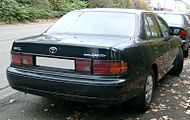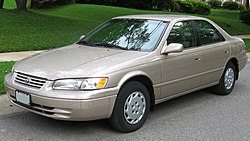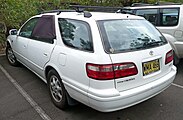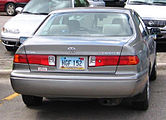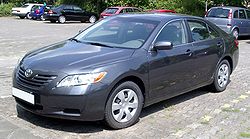Toyota Camry
| Toyota Camry | |
|---|---|
| Production period: | since 1983 |
| Class : | Middle class |
| Body versions : | Sedan , hatchback , station wagon |
| Previous model: | Toyota Cressida |
The Toyota Camry is a car model of the middle class of Toyota . It replaced the Toyota Cressida , whose import in Europe was not discontinued until autumn 1985 and in the other export markets only in autumn 1992.
The name Camry is the English pronunciation of the Japanese word "kan-muri" and means "crown". With this model, Toyota made the change from rear-wheel to front-wheel drive in the middle class.
The first generation was also sold as a hatchback version (liftback), and a station wagon was also offered from the second to the fourth generation. In America the Camry served as the basis for the Lexus ES and in Japan as the basis for the Toyota Windom and the Toyota Vista . Holden built it as the Holden Apollo . Since spring 2000 it has also been produced by the Toyota subsidiary as Daihatsu Altis .
Celica Camry (1980-1983)
At the Japanese Toyota factory in Tsutsumi, the first Camry to be referred to as the Toyota flagship rolled off the assembly line in the fall of 1980. The car was sold under the name Toyota Celica Camry in Asia and had rear-wheel drive.
It was based on the Toyota Corona and was a more sophisticated version of this model. As Toyota Vista it was offered from 1982 through its own Toyota Vista dealer network.
Camry (V10, 1983-1986)
| 1st generation | |
|---|---|
|
Toyota Camry notchback (1983–1986) |
|
| Production period: | 1983-1986 |
| Body versions : | Limousine , station wagon |
| Engines: |
Otto engines : 1.8–2.0 liters (55–68 kW) Diesel engine : 2.0 liters (55 kW) |
| Length: | 4440 mm |
| Width: | 1690 mm |
| Height: | 1395 mm |
| Wheelbase : | 2600 mm |
| Empty weight : | 1045 kg |
At the beginning of 1983, the Toyota Camry then appeared as an independent model series with transverse engine and front-wheel drive.
It was produced from January 1983 as a four-door sedan and as a five-door hatchback (liftback) and was also offered in Germany in addition to the Toyota Cressida . The body shape followed the contemporary taste of the 1980s and can be described as angular or box-shaped.
An in-line four-cylinder engine with an overhead camshaft (double falling-flow register carburetor) and a displacement of 1832 cm³ was offered. It developed 66 kW (90 hp). The vehicle was 4415 mm long, 1690 mm wide and 1395 mm high (liftback 1370 mm) and weighed 1035 (sedan) or 1055 kg (liftback) empty. From summer 1984, GLi models with a two-liter engine were also offered.
Camry (CV20 / SV21 / VZV21, 1986-1991)
| 2nd generation | |
|---|---|
|
Toyota Camry Sedan (1986-1991) |
|
| Production period: | 1986-1991 |
| Body versions : | Limousine , station wagon |
| Engines: |
Otto engines : 1.8–2.5 liters (64–118 kW) Diesel engine : 2.0 liters (62 kW) |
| Length: | 4520 mm |
| Width: | 1690 mm |
| Height: | 1374 mm |
| Wheelbase : | 2600 mm |
| Empty weight : | 1240 kg |
The second generation Camry had the in-house designations CV20, SV 21 and VZV 21 and came onto the market in autumn 1986. It was offered again as a four-door notchback sedan, but there was no longer a hatchback variant (liftback). As a replacement for this, a station wagon appeared in the range for the first time.
In Europe, the Camry replaced the Toyota Cressida , which was no longer available there since autumn 1985 , while it was offered in parallel to this in North America. The body shape had been smoothed and rounded. The drag coefficient ( drag coefficient ) reached 0.35. The sedan had a length of 4500 mm, a width of 1712 mm and a height of 1365 mm, the station wagon had the dimensions 4625 mm / 1712 mm / 1375 mm. The car was as GLi with catalytic converter and 1984 cm³ displacement with an output of 89 kW (121 PS) - initially also without a catalyst with 94 kW (128 PS), XL turbo diesel with 1981 cm³ displacement and 62 kW (84 PS) as well offered as a V6 GXi Kat with 2490 cm³ displacement and 118 kW (161 PS).
This Camry was also very successful in North America and formed the basis for the Lexus ES , which was offered from the end of 1989 . It was also the basis for the Holden Apollo, which was offered from the end of 1989 .
Only around 3000 vehicles of this model generation were sold in Germany, around 60 percent of which were in the estate version. In Austria, the 121 hp saloon was also offered with all-wheel drive. The station wagon (or Sportswagon as it was called in Switzerland) with all-wheel drive and an output of 117 hp was also available in Switzerland.
The types 466 (closed sedan; versions 001/9, 002/0, 003/2, 004/4, 005/6 and 006/8) and 469 (station wagon closed; versions 001/2, 002/4, 003 / 6) equipped with a regulated catalytic converter , but not yet marked accordingly in the vehicle documents on the day of its first registration, as the key OTTO / GKAT key no. 51 was not yet included in the list of drive types. A corresponding transfer resulted in the classification in a more favorable tax class of the vehicle tax .
Camry (SXV10 / VCV10, 1991-1996)
| 3rd generation | |
|---|---|
|
Toyota Camry Sedan (1991-1996) |
|
| Production period: | 1991-1996 |
| Body versions : | Limousine , station wagon |
| Engines: |
Otto engines : 2.2–3.0 liters (100–138 kW) |
| Length: | 4725 mm |
| Width: | 1770 mm |
| Height: | 1415 mm |
| Wheelbase : | 2620 mm |
| Empty weight : | 1355-1415 kg |
The completely redesigned third-generation Camry was presented in August 1991, with sales starting in late September. The model series ran under the factory designation SXV10 or VCV10. The station wagon version produced in North America was delivered in Germany from June 1992.
Due to the larger external dimensions compared to the predecessor, more space was also available in the interior. The four-door sedan had a length of 4725 mm, a width of 1770 mm and a height of 1415 mm. The curb weight was 1355 to 1415 kg depending on the equipment. The Camry was offered in versions 2.2 GL and 3.0 V6 GX.
The new body was rounder and more streamlined than that of the predecessor. The trunk volume was 517 liters. The drag coefficient was given as 0.31. The body shape was similar to that of the Lexus models. Compared to the German competition, the equipment was already very extensive ex works. The rear window of the station wagon with two wipers is still considered unique today. A third row of seats was also offered for the station wagon.
As the first vehicle in the upper mid-range, the car had an airbag , an electronic four-sensor anti-lock braking system and side impact protection in the doors as standard . The new engines (5S-FE with 2164 cm³ and 136 HP or 3VZ-FE with 2958 cm³ (V6) and 188 HP) had larger displacements with more elasticity and power. A diesel variant was no longer offered.
In Japan this generation was called the Toyota Scepter . In Australia it was the successor to the Toyota Cressida from 1993 and was offered as the Toyota Vienta until 1997 .
Camry (XV20, 1996-2001)
| 4th generation | |
|---|---|
|
Toyota Camry (1996-2000) |
|
| Production period: | 1996-2001 |
| Body versions : | Limousine , station wagon |
| Engines: |
Petrol engines : 2.2-3.0 liters (93-140 kW) |
| Length: | 4820 mm |
| Width: | 1780 mm |
| Height: | 1400 mm |
| Wheelbase : | 2670 mm |
| Empty weight : | 1460 kg |
This Camry was a further development of the third generation and was manufactured from August 1996. The station wagon presented in mid-1997 was only offered in Japan under the name Toyota Camry Gracia .
The body shape became less rounded and slightly wedge-shaped. The drag coefficient was again given as 0.31. The 3VZ-FE engine used in the previous V6 model was replaced by the 1MZ-FE engine with a slightly increased displacement (2995 instead of 2958 cm³), which now developed 140 kW instead of 138 kW (190 hp instead of 188 hp). The 2.2-l four-cylinder 5S-FE engine was offered with a slightly reduced output of 96 kW instead of the previous 100 kW (131 PS instead of the previous 136 PS), but like the V6, it now achieved the Euro 2 emissions standard .
An extended wheelbase led to more legroom in the interior, and width and height increased slightly. The equipment has been improved. Softer materials were used in the interior. Automatic climate control was standard in all models, and a passenger airbag was now also available. A double DIN slot was available for the radio installation, in which either a DIN radio and a placeholder or a DIN radio and an underlying CD player in DIN format were installed at the factory. Side airbags integrated into the front seat backs became standard equipment from around July 1998.
A sporty S-model came onto the market at the 1997 IAA . This differed from the production model in that the body was lowered by three centimeters, 17-inch light alloy wheels with low-profile tires, front and rear aprons and a different radiator grille. However, the interior of the S model showed no differences.
In April 2000 there was a facelift. The front headlights (now under clear glass) and the rear lights were enlarged, while the bumpers and grille were slightly modified. In conjunction with the V6 engine, traction control was now standard and the 2.2-liter engine had cruise control . The output of the V6 was slightly reduced to 135 kW (184 hp), that of the 2.2-liter four-cylinder to 93 kW (126 hp). In return, the models have now achieved the Euro 3 emissions standard.
This Camry was available in two different engine variants:
- 2.2 liter displacement with 96 kW (131 hp) SXV 20 series, 5S-FE engine, 08.1996-04.2000
- 2.2 liter displacement with 93 kW (126 hp) model series SXV 20, 5S-FE engine, 04.2000-09.2001
- 3.0 liter displacement, V6 with 140 kW (190 hp) model series MCV 20, 1MZ-FE engine, 08.1996-04.2000
- 3.0 liter displacement, V6 with 135 kW (184 PS) model series MCV 20, 1MZ-FE engine, 04.2000-09.2001
The 3.0 V6 was only available with an automatic transmission (four stages), the four-cylinder version was offered either with a manually shifted five-speed transmission or with an automatic. Both variants were one and the same automatic transmission, each of which had been tailored differently to the engines.
In the USA, a coupé and a convertible of this generation were also produced under the name Toyota Camry Solara from autumn 1998 and the end of 2003 .
Since spring 2000, an identical limousine vehicle has also been sold in Japan as the Daihatsu Altis and is mostly replaced by a new model at the same time as the Camry.
Technical specifications
- Dimensions: length 4765 mm, width 1785 mm, height 1430 mm
- Wheelbase: 2670 mm
- Turning circle: 11.8 m
- Trunk: 520 liters
- Empty weight: 1460 to 1480 kg
- Acceleration 0 to 100 km / h: 10.4s (2.2 manual transmission) / 11.7s (2.2 automatic) / 9s (3.0 automatic)
- Consumption: 9.0 (2.2 manual transmission) / 9.8 (2.2 automatic) / 11.6 (3.0 automatic) liters of premium gasoline
- Top speed: 200 (2.2 manual transmission) / 195 (2.2 automatic) / 220 (3.0 automatic) km / h
- Tank capacity: 70 liters
Camry (XV30, 2001-2006)
| 5th generation | |
|---|---|
|
Toyota Camry (2001-2004) |
|
| Production period: | 2001-2006 |
| Body versions : | limousine |
| Engines: |
Gasoline engines : 2.4–3.3 liters (117–168 kW) |
| Length: | 4805 mm |
| Width: | 1795 mm |
| Height: | 1490 mm |
| Wheelbase : | 2720 mm |
| Empty weight : | 1465-1645 kg |
The fifth generation Camry was presented at the Frankfurt International Motor Show (IAA) in September 2001.
The body had a pronounced wedge shape with a flat C-pillar and the "family face" of the other Toyota models. The aerodynamic body was able to reduce the drag coefficient to 0.28. The new platform, which enabled a 50 millimeter longer wheelbase, brought more space in the interior. Legroom increased by 40 millimeters in the front and back, head and shoulder room by 20 millimeters. The external dimensions increased in length by 15 millimeters, in width by 10 millimeters and in height by 70 millimeters. The trunk volume grew to 587 liters.
The ride comfort was improved, among other things, by longer spring travel on the optimized wheel suspensions and by measures to reduce noise. The power steering was tuned more directly. For the version sold in Germany, there were 16-inch light-alloy wheels with a brake system that had internally ventilated discs. A version with 15-inch wheels was also built for other countries.
The basic engine in Germany was a 2.4-liter in-line four-cylinder engine (2362 cm³ displacement), which replaced the 2.2-liter engine previously used. It was based on the Toyota Previa engine . The four-valve engine had two overhead camshafts and variable timing (VVT-i) as well as an electronic accelerator pedal ( drive-by-wire ). The power was specified with 112 kW (152 PS) and the maximum torque of 218 Newton meters. The manual transmission had five gears. The top speed was 210 km / h, the acceleration from 0 to 100 km / h 9.4 seconds. A version with a four-stage automatic was also available as an option.
A light alloy V6 with a displacement of 2995 cm³ was also available as the engine. This engine also had an electronically controlled throttle valve ( drive-by-wire ). Models with this engine had an electronically controlled four-stage automatic (4ECT-i), traction control (TRC) and stability control (VSC). The 24-valve engine developed 137 kW (186 hp) at 5300 rpm. It accelerated from 0 to 100 km / h in 9.1 seconds. The maximum speed was given as 225 km / h; the torque was 273 Newton meters.
Motor variants:
- 2.4 liter (2362 cm²) displacement in-line four-cylinder with 112 kW (152 hp), 11.2001–07.2004
- 3.0 liter (2995 cm²) displacement V6 with 137 kW (186 hp), 11.2001–07.2004
Technical specifications
- Dimensions: length 4815 mm, width 1795 mm, height 1500 mm
- Wheelbase: 2720 mm
- Turning circle: 12 m
- Boot space: 587 liters
- Empty weight: from 1465 to 1645 kg (2.4 counter to 3.0 executive)
- Acceleration 0 to 100 km / h: 9.4 s (2.4 switch) / 10.4 s (2.4 Auto) / 9.1 s (3.0 Auto)
- Consumption: 8.6 (2.4 switch) / 9.7 (2.4 car) / 11.0 (3.0 car) liters of premium gasoline
- Maximum speed: 210 (2.4 switch) / 200 (2.4 car) / 225 (3.0 car) km / h
- Tank capacity: 70 liters
Camry XV40 (2006-2011)
| 6th generation | |
|---|---|
|
Toyota Camry (2006-2011) |
|
| Production period: | 2006-2011 |
| Body versions : | limousine |
| Engines: |
Otto engines : 2.4–3.5 liters (108–200 kW) Otto hybrid : 2.4 liters (140 kW) |
| Length: | 4805 mm |
| Width: | 1820 mm |
| Height: | 1470 mm |
| Wheelbase : | 2776 mm |
| Empty weight : | 1489 kg |
Since the end of 2006, the Camry has not only been produced in Asia, but also in Georgetown (Kentucky) .
The base model had a four-cylinder engine with a displacement of 2.4 liters, which developed 108 kW (147 hp). On the North American market, the standard version had a displacement of 2.5 l and 127 kW (169 hp) or 134 kW (179 hp). Available from the LE version with a 3.5 liter six-cylinder engine and 200 kW (268 hp). A six-speed automatic transmission was also new in the V6, which replaced the older five-speed version of the four-cylinder version. The Toyota Camry Hybrid was powered by the combination of a 2.4 liter four-cylinder and an electric drive. The total output was given as 140 kW (187 hp).
In addition to the safety equipment with ABS, ESP (only optional) and seven airbags, the 2007 model year Camry also had satellite radio , DVD navigation, xenon lights , LED taillights and Bluetooth technology.
It continued to be one of the best-selling vehicles in the North American market. In 2011 alone, 308,510 vehicles were sold in the United States. There was also a coupe and convertible version of this between summer 2004 and mid-2009, which were sold as the Toyota Camry Solara .
Camry (XV50, since 2011)
| 7th generation | |
|---|---|
|
Toyota Camry (since 2011) |
|
| Production period: | since 2011 |
| Body versions : | limousine |
| Engines: |
Otto engines : 2.0–3.5 liters (109–204 kW) Otto hybrid : 2.5 liters (149 kW) |
| Length: | 4805-4850 mm |
| Width: | 1825 mm |
| Height: | 1480 mm |
| Wheelbase : | 2775 mm |
| Empty weight : | 1447-1615 kg |
The seventh generation of the Camry was introduced in August 2011 and sold from September of the same year. This generation is not imported to Europe either.
Despite the visual similarities to the previous model, the body is completely new. The engines have also been partially revised, in particular the performance of the entry-level engine has been increased. The 3.5-liter engine and the hybrid model are still linked to higher equipment lines.
In contrast to its predecessors, the model offered in Japan optically corresponds to the version for the other Asian markets and is only available with a hybrid drive .
In the USA, this generation is no longer available with a manual transmission; instead, a six- speed automatic transmission is installed as standard in the petrol engines . The hybrid variant is equipped with a continuously variable transmission . Also standard are ESP , ten airbags and various comfort features.
The 2.0-liter machine is only available on the Russian market.
Technical specifications
| model | 2.0 VVT-i | 2.0 VVT-i | 2.0 | 2.5 Dual VVT-i | 3.5 Dual VVT-i | 3.5 Dual VVT-i |
|---|---|---|---|---|---|---|
| Number of cylinders | R4 | R4 | R4 | R4 | V6 | V6 |
| Displacement (cm³) | 1998 | 1998 | 1998 | 2494 | 3456 | 3456 |
| Max. Power (kW / PS) | 109/148 at 6000 | 110/150 at 6500 | 123/167 at 6500 | 133/181 at 6000 | 183/249 at 6200 | 204/277 at 6200 |
| Max. Torque (Nm) | 190 at 4000 | 199 at 4600 | 199 at 4600 | 231 at 4100 | 346 at 4700 | 346 at 4700 |
| Top speed (km / h) | 190 | 210 | 200 | 210 | 210 | 210 |
| Transmission (standard) | 4-stage automatic | 6-stage automatic | 6-stage automatic | 6-stage automatic | 6-stage automatic | 6-stage automatic |
| Acceleration (0-100 km / h) | 12.5 s | 10.4 s | 10.8 s | 9.0 s | 7.1 s | 7.1 s |
| Combined consumption (l / 100 km) | 8.3 N | 7.2 N | 7.1 N | 7.8 N | 9.3 N | 9.3 N |
| Tank capacity | 70 l | 70 l | 70 l | 70 l | 70 l | 70 l |
Camry (XV70, since 2017)
| 8th generation | |
|---|---|
|
Toyota Camry SE (since 2017) |
|
| Production period: | since 2017 |
| Body versions : | limousine |
| Engines: |
Otto engines : 2.0–3.5 liters (110–222 kW) Otto hybrid : 2.5 liters (160 kW) |
| Length: | 4885-4905 mm |
| Width: | 1840 mm |
| Height: | 1445-1455 mm |
| Wheelbase : | 2825 mm |
| Empty weight : | 1495-1700 kg |

The eighth generation of the Camry was unveiled at the North American International Auto Show in Detroit in January 2017 . In America and Japan, the market launch took place in July 2017, the Australian market followed in November 2017. The XV70 is built in Georgetown , Toyota , Chachoengsao and Guangzhou . The new Camry is based on the Toyota New Global Architecture (TNGA) platform, which the Toyota C-HR also uses.
The Camry has also been marketed in Europe again since April 2019. However, only the hybrid version is available here. It is also intended to replace the Avensis , which expired in 2018 .
For the first time since 1991, all-wheel drive is to be installed in the Camry again from 2020. This variant is reserved for the North American market.
Furnishing
The vehicle is offered in North America in five trim levels. These equipment lines can be distinguished, among other things, on the basis of different front designs.
- L.
- LE
- SE
- XLE
- XSE
Technical specifications
| 2.0 (1) | 2.5 | 2.5 (2) | 3.5 V6 (1) | 3.5 V6 | 2.5 hybrid | |
|---|---|---|---|---|---|---|
| Construction period | since 04/2018 | since 11/2017 | since 07/2017 | since 11/2017 | since 07/2017 | |
| Engine characteristics | ||||||
| Engine type and number of cylinders |
R4 petrol engine | V6 petrol engine | R4 petrol engine + electric motor | |||
| Displacement | 1998 cc | 2494 cc | 3456 cc | 2487 cc | ||
| Internal combustion engine power | 110 kW (150 PS) at 6500 | 133 kW (181 hp) at 6000 | 151 kW (205 PS) at 6600 | 183 kW (249 hp) for 5000-6600 | 222 kW (302 hp) at 5000-6600 | 131 kW (178 hp) at 5700 |
| Electric motor power | - | 88 kW (120 PS) | ||||
| System performance | - | 160 kW (218 hp) | ||||
| Max. Internal combustion engine torque | 192 Nm at 4700 | 231 Nm at 4100 | 249 Nm at 5000 | 356 Nm at 4700 | 221 Nm at 3600-5200 | |
| Max. Torque electric motor | - | 202 Nm | ||||
| Power transmission | ||||||
| Drive, as standard | Front wheel drive | |||||
| transmission | 6- speed automatic transmission | 8-speed automatic transmission | Stepless transmission | |||
| Readings | ||||||
| Top speed | 210 km / h | k. A. | 220 km / h | 180 km / h | ||
| Acceleration 0-100 km / h |
11.0 s | 9.9 s | k. A. | 7.7 s | 6.9 s | 8.3 s |
| Fuel consumption over 100 km | 7.1 l super | 8.3 l super | k. A. | 8.7 l super | 4.3–4.4 l super | |
| Tank capacity | 60 l | 50 l | ||||
Registration numbers
In the first sales year 2019, 647 Toyota Camry VX70s were newly registered in the Federal Republic of Germany .
literature
- Toyota Camry, 1983-96. Chilton's Total Car Care Repair Manuals, Haynes Manuals, August 1998, ISBN 978-0-8019-8955-1 .
Individual evidence
- ↑ see announcement of the Federal Minister for Transport of June 26, 1997 StV 14 / 36.17.06-01 / 9 Va 97 No. 3b
- ↑ Introduction Camry 2012 , accessed April 3, 2012
- ↑ Manufacturer's website , accessed on April 3, 2012
- ↑ Seat sample in the new mid-range bestseller. auto-motor-und-sport.de, January 10, 2017, accessed on January 22, 2018 .
- ↑ Holger Wittich, Andreas Of, Gregor Hebermehl: Toyota Camry AWD (2019): After 28 years again with all-wheel drive. In: auto-motor-und-sport.de. November 14, 2019, accessed November 15, 2019 .
- ↑ Which 2018 Toyota Camry Trim Should I Buy: L, LE, SE, XSE or XLE? cars.com, June 23, 2017, accessed May 23, 2018 .
- ↑ How the 2018 Toyota Camry's Trims Look Different. cars.com, January 13, 2017, accessed May 23, 2018 .
- ↑ New registrations of passenger cars in December 2019 by brand and model series. Retrieved January 12, 2020 .
Web links
- Official website (English)







